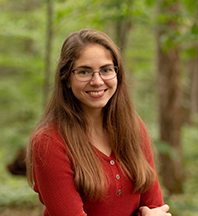Week of August 21, 2022 – August 27, 2022
by Bridget Jones, Environmental Educator
Among the green leaves of summer, flowers bring splashes of color to fields and forests across Baltimore Woods. Their vibrant colors and unique shapes catch our attention and entice us to pause for a moment, slow down, and appreciate their beauty. But the striking colors and patterns of flowers evolved to attract attention from a very different audience: bees, butterflies, hummingbirds, and other pollinators. The physical features of flowers act as visual cues, drawing in pollinators and providing a road map straight to the pollen source.
Flower colors act as beacons for certain pollinators. Imagine a garden bursting with every flower color imaginable. The visual variety might be overwhelming for us, but pollinators would hone in on flowers of their preferred color. Bees, for example, fly towards purple and blue flowers, while hummingbirds prefer flowers that are bright red. Flowers also signal to pollinators through their shapes. Hummingbirds, with long tongues and the ability to hover, are well suited for flowers that have long, tube-like shapes. Bees and butterflies, meanwhile, prefer flowers with a wide space on which to land.
Looking closely at flowers reveals even more details that attract pollinators. If you examine a flower head on, you’ll notice that many petals have visual cues that point directly to the flower’s center. They may have arrows or lines that direct pollinators like runways, or darker colors at the center that act like targets. These patterns are not random; instead, they show pollinators exactly where to find pollen. Some of these visual cues are invisible to human eyes, only revealed in shades visible on the ultraviolet spectrum. These traits make it easier for pollinators to find a food source. This also benefits plants: the easier it is for pollinators to reach pollen, the more effectively they can spread it to new flowers.
Just as we find flowers beautiful and alluring, pollinators are also drawn in by flowers’ physical characteristics. As the flowers of late summer emerge, consider how these traits help them attract bees, birds, and butterflies. How do their colors make them noticeable? Do their shapes make pollen more accessible to some creatures than to others?


